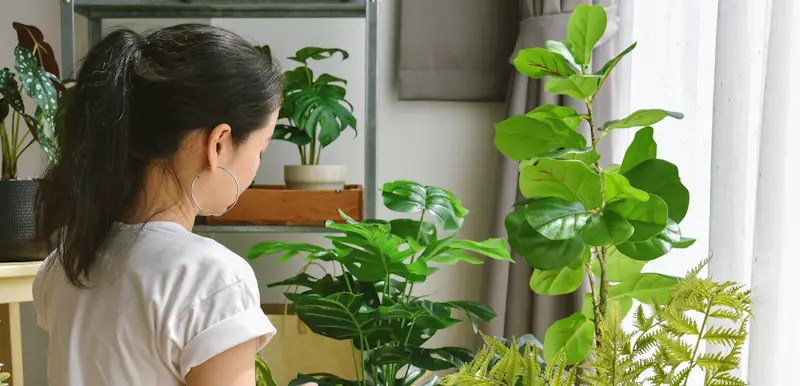Plant propagation helps grow more of a plant without spending a dime! For lovers of household plants like fiddle leaf fig, if you are considering having more of this plant in your home, then propagation is what you need. However, for proper propagation, you must understand the right methods; otherwise, your plant might not survive.
When you want to propagate fiddle leaf fig, the first thing to do is to prepare the stem cuttings and the propagation container. Next, you will fill the propagation container with water and place the stem cuttings in the container finally, add a rooting hormone and keep the stem cutting warm.
Propagating fiddle leaf fig is easy; however, without adequate knowledge, you would be unable to perform the process, and the plant will not be healthy.

Can You Propagate Fiddle Leaf Fig Leaf?
Fiddle leaf fig, also known as Ficus lyrata, is a plant native to Western Africa. It is a common household plant. With its violin-shaped leaves, this plant is a beautiful indoor plant that could grow to a height of 6 to 10 feet when mature. The fiddle leaf fig is easy to plant and best maintained under bright indirect sunlight.
Sometimes, certain reasons could make you consider propagating this plant. For instance, you might want more of this beautiful plant in different areas around the house. Now, while this plant can be propagated, a single leaf propagation cannot work. For a successful fiddle leaf fig propagation, you will need more than just a leaf.
Although, if you propagate a fiddle leaf fig leaf in water, the leaf will remain alive for a while. However, you need to know that the leaf will not grow beyond that point into a new plant. So, since the reason for propagation is to recreate more of a plant, you would agree there is no point in propagating a fiddle leaf fig leaf.
How Do You Propagate Fiddle Leaf Fig
Since we already mentioned that propagating a fiddle leaf fig leaf will not work, you might be wondering how to propagate this plant best. You need a fiddle leaf fig stem just below a node. There are three different methods of propagation; soil propagation, water propagation, and air layering. Let us consider each of these methods below.
Method 1 (Soil Propagation)
To successfully use this method, you need a properly sterilized cutter, propagation soil in a container/planter, a rooting hormone, and a clear plastic bag. Having gotten all we mentioned, follow the steps explained below.
Step 1
You first need to cut the fiddle leaf fig stem just below a node with a clean, well-sterilized cutter. In case you do not know what nodes are, they are the spots on a stem where the leaves grow from and where roots also come from during propagation. For a good result, ensure you have about 3 nodes, then cut shortly below the nodes.
Step 2
After cutting from the stem nodes, the next step is to dip the cutting into a rooting hormone. The purpose of doing this is to help fasten the propagation.
Step 3
Get your properly watered propagation soil in a container/planter, then dig a hole wide enough for the cut fiddle leaf fig. This is to help keep the rooting hormone intact on your cutting. Now, place the cutting inside the hole and ensure it is about 1 – 2 inches deep in the soil.
Also, ensure you cut any leaf around that could probably touch the soil; otherwise, the leaf would rot and could also affect the whole cutting. Having done that, bury the soil around the cutting to make it compact well.
Step 4
Once you get to this stage, your propagation is almost a success! However, one important thing you need to do is to place a plastic bag on your cutting. The reason for doing this is to allow water loss through transpiration to return to the plant.
When placing the plastic bag, ensure you get twigs which would help prevent the plastic bag from touching the leaves. Once that is done, place the container/planter where the cutting could get bright indirect sunlight. Within 4 – 6 weeks, the fiddle leaf fig plant should have sprouted roots and begin to produce new leaves.
Method 2 (Water Propagation)
This method is a bit similar to soil propagation. However, the only difference between both methods is that this propagation occurs in water instead of soil. For water propagation, repeat step 1 from the soil propagation method. The next thing to do is place the cutting into fresh water in a container, then place it where it can get bright indirect sunlight.
For best results, endeavor to change the water once in a while, allowing the plant to get the needed oxygen for survival. Within 4 to 6 weeks, your cutting would have begun to sprout roots. Once the roots have grown to a certain extent, you can then plant the root into proper soil and allow it grow.
Method 3 (Air Layering)
With this method, you need to cut the plant so it grows its root system while still attached to the mother plant. And when the branch has grown its roots, it will be pruned off and planted separately. This is one of the best ways of propagating large sections of the plant without risking the death of the plant.
Fiddle Leaf Fig Propagation
One way to propagate fiddle leaf figs is by propagating the cuttings directly in the soil. However, this process often takes a long time, so if there is no new growth on the plant for a while, you should not be worried. This process involves a lot of underground processes, developing a new root system.
All you need to do is cut the fiddle leaf fig and plant it directly in the soil. You can also fill up the soil end of the cut fig with rooting hormone powder to speed up the development of the root. You must ensure the soil remains moist, and you need to cover the soil above the plant with a plastic bag.
The plastic bag will create a greenhouse effect that will aid the cuttings’ development. When you see new growth sprouting on the top of the cutting, you have finally propagated the fiddle leaf fig; it is rooted, and you can take care of it like any other plant.

Where To Cut Fiddle Leaf Fig For Propagation
One important thing you should know before propagating fiddle leaf fig is where to cut the fig. This is the first thing you must do, and the materials you need are rooting hormone and fiddle leaf fig plant. You also need a pot of soil, a water jar filled with water, and scissors.
To cut the fiddle leaf fig, you must cut it right above an existing leaf; on no condition should you cut above a leaf. You also need to remove any leaves that can fall in the soil. Next, wet the stem and dip it in the rooting hormone. Place the stem in a pot of moist soil or a jar of water.
Place the stem close to a sunny window; you should ensure it remains moist by watering it regularly. After a month, the root should develop and should reach a length of about 2 inches within two months. Once the roots are two inches long, you can plant them.
Also read: How to Repot a Fiddle Leaf Fig [COMPLETE GUIDE]
Final Thoughts
While you are invested in the propagation of your fiddle leaf fig, you must ensure you propagate it in the right season. You can follow the process in detail; if you do not propagate in the right season, there will be no growth. You should propagate it in the warm season.
Keep reading:
- Why Is My Fiddle Leaf Fig Dropping Leaves? [GUIDE]
- How to Repot a Fiddle Leaf Fig
- Fiddle Leaf Fig Outdoors – Can They Survive? [ANSWERED]
- How To Propagate A String Of Hearts? [GUIDE]
Victoria is the owner and main author of hobby plants. She loves spending her free time in her garden planting and taking care of her plants. Victoria hopes you enjoy the content here!